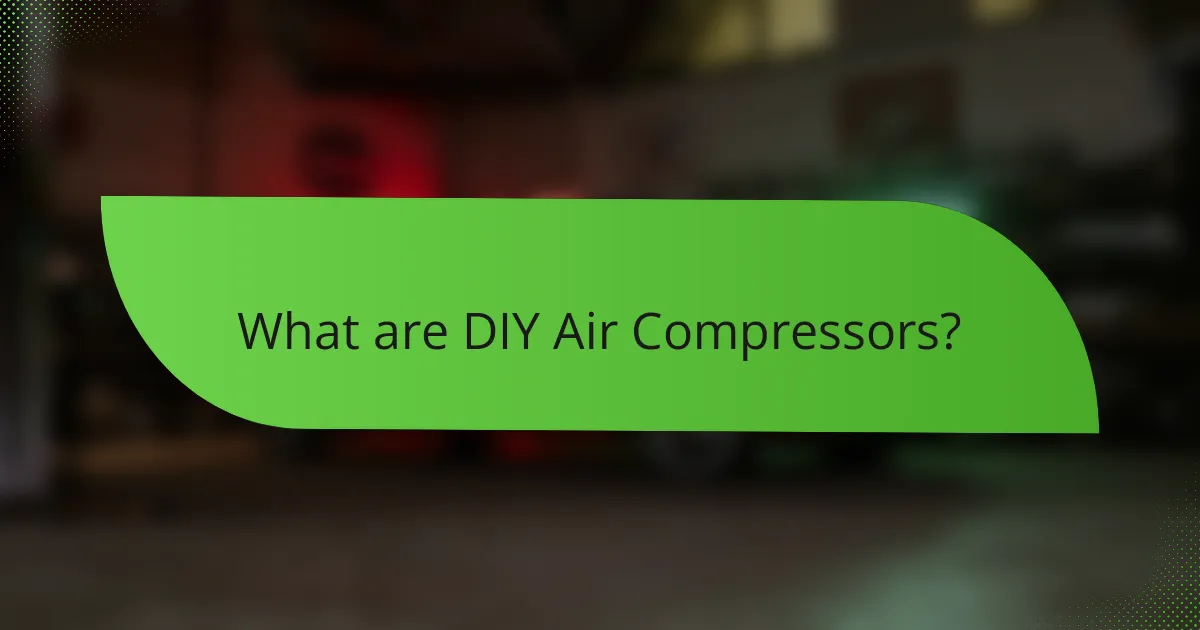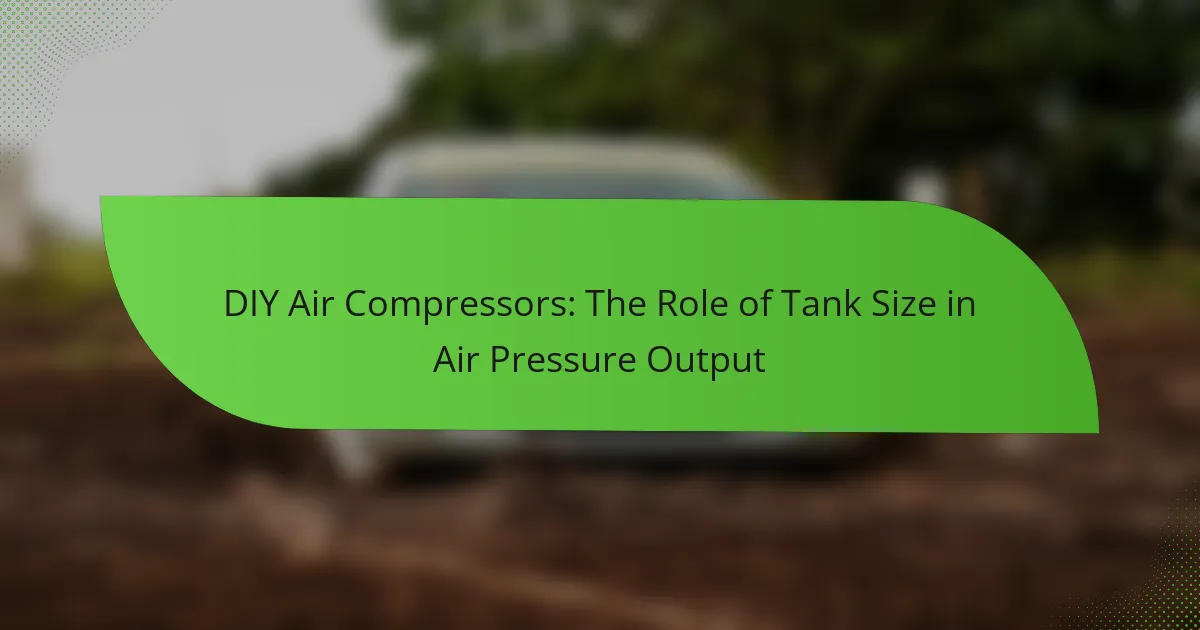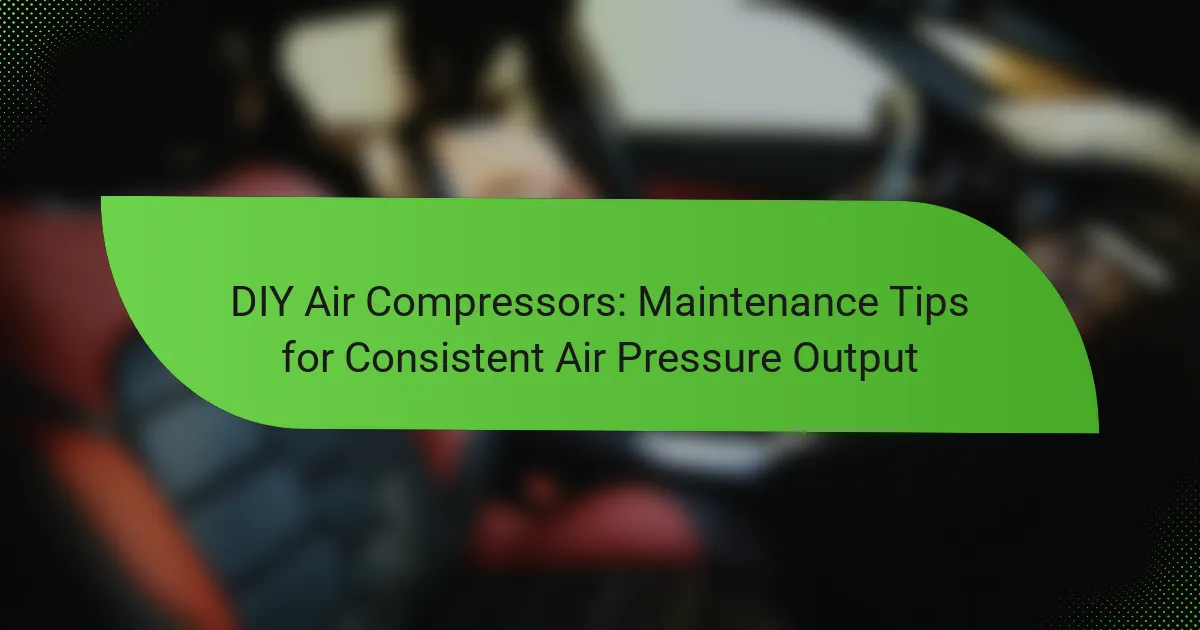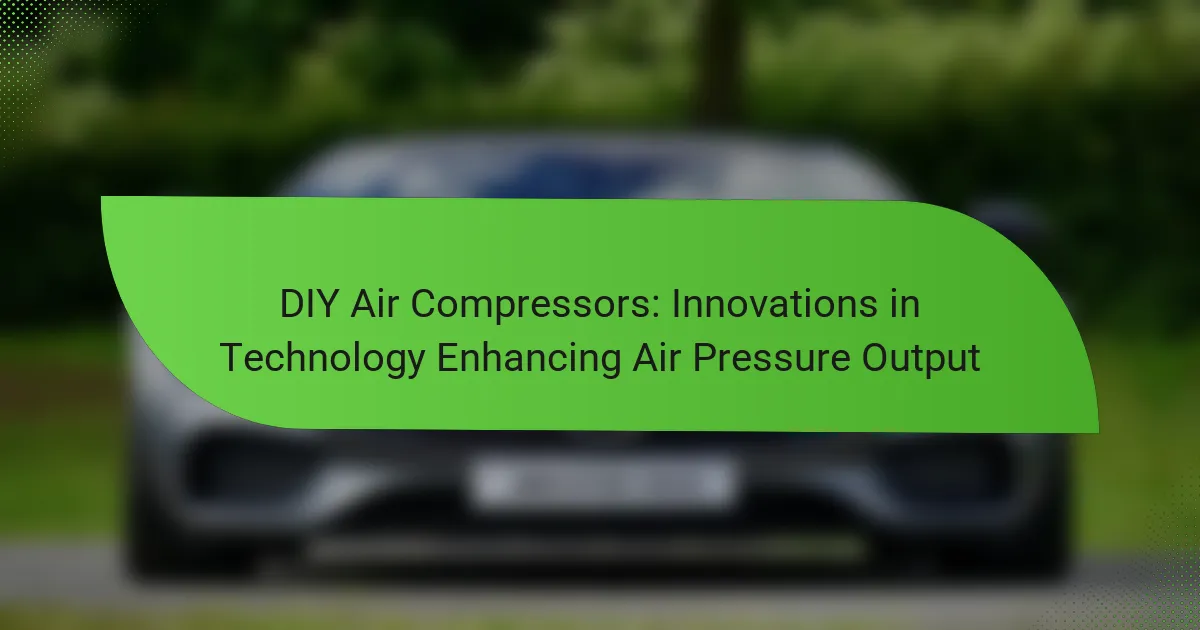DIY air compressors are devices designed to generate compressed air for a variety of applications, utilizing components such as electric motors, tanks, and pumps. This article explores the construction and customization of DIY air compressors, highlighting their cost-effectiveness compared to commercial alternatives. Key applications include powering pneumatic tools, inflating tires, and spray painting. The article also explains the fundamental mechanics of air pressure involved in the operation of these compressors, detailing the process of drawing in and compressing air into a storage tank. Understanding these concepts enhances both practical skills and knowledge of air pressure dynamics.

What are DIY Air Compressors?
DIY air compressors are devices that create compressed air for various applications. They are typically built from existing components such as electric motors, tanks, and pumps. DIY air compressors can be customized for specific needs, offering flexibility in design and usage. Common applications include powering pneumatic tools, inflating tires, and spraying paint. Many DIY enthusiasts create these compressors to save costs compared to commercial options. Building a DIY air compressor can also enhance understanding of air pressure mechanics. The basic principle involves drawing in air and compressing it into a storage tank. This process increases air pressure, making it usable for different tasks.
How do DIY Air Compressors differ from commercial models?
DIY air compressors typically have lower power and efficiency compared to commercial models. DIY versions often use repurposed or less powerful components. This results in reduced air pressure output and slower refill times. Commercial models are designed for higher performance and durability. They usually feature advanced motors and larger tanks. This allows for consistent air pressure and faster recovery times. Additionally, commercial air compressors often come with warranties and support. This is less common with DIY models.
What are the key components of a DIY Air Compressor?
The key components of a DIY air compressor include a motor, a pump, a tank, and a pressure switch. The motor provides the necessary power to drive the pump. The pump compresses the air and increases its pressure. The tank stores the compressed air for later use. The pressure switch regulates the air pressure within the tank, turning the motor on and off as needed. Additional components may include filters and hoses for air delivery. Each component is essential for the efficient operation of the air compressor.
How does the design impact the performance of a DIY Air Compressor?
The design of a DIY air compressor significantly affects its performance. Key design elements include the size of the tank, the type of motor, and the efficiency of the compressor head. A larger tank can store more air, leading to increased pressure output over time. The motor’s power rating directly influences the compressor’s ability to maintain consistent airflow. Additionally, the compressor head’s design impacts how effectively air is compressed. Research shows that optimized designs can improve efficiency by up to 30%. Therefore, thoughtful design choices can enhance overall performance and output of a DIY air compressor.
What is air pressure output in the context of DIY Air Compressors?
Air pressure output in DIY air compressors refers to the amount of compressed air produced by the compressor, measured in pounds per square inch (PSI). This output determines the compressor’s effectiveness in powering tools and inflating objects. Common air pressure outputs for DIY compressors range from 70 to 150 PSI. Higher PSI ratings indicate greater capacity for heavy-duty tasks. The efficiency of a DIY air compressor often correlates with its air pressure output. Therefore, understanding this output is essential for selecting the right compressor for specific tasks.
Why is air pressure output important for various applications?
Air pressure output is crucial for various applications because it directly influences the performance and efficiency of pneumatic tools. High air pressure enables tools to operate effectively, providing the necessary force for tasks such as drilling, sanding, and inflating. For instance, a standard air compressor operates at 90 PSI, which is optimal for most pneumatic tools. In industrial settings, precise air pressure control enhances productivity and reduces energy consumption. According to the U.S. Department of Energy, maintaining optimal air pressure can lead to a 20-30% reduction in energy costs. Additionally, proper air pressure ensures safety by preventing tool malfunction or accidents. Thus, understanding air pressure output is essential for maximizing the functionality of air compressors in various applications.
How can one measure the air pressure output of a DIY Air Compressor?
To measure the air pressure output of a DIY air compressor, use a pressure gauge. Attach the gauge to the compressor’s output valve. Turn on the compressor and allow it to build pressure. Observe the reading on the pressure gauge. The reading indicates the air pressure output in psi (pounds per square inch). Most DIY air compressors can reach between 90 to 150 psi. Ensure the gauge is calibrated for accurate measurements. Regular checks help maintain compressor efficiency and performance.
What factors influence the efficiency of DIY Air Compressors?
The efficiency of DIY air compressors is influenced by several key factors. These include the compressor design, which affects airflow and pressure generation. The motor power directly impacts the compressor’s ability to maintain pressure. Additionally, the quality of components, such as valves and fittings, can lead to air leaks, reducing efficiency. The tank size also plays a role; larger tanks store more air, allowing for longer usage before needing to refill. Furthermore, the ambient temperature can affect air density and compressor performance. Lastly, maintenance practices, such as regular cleaning and lubrication, are crucial for optimal operation.
How do motor power and tank size affect compressor efficiency?
Motor power and tank size significantly affect compressor efficiency. Higher motor power allows the compressor to generate more air pressure quickly. This increased pressure can lead to faster recovery times during use. A larger tank size stores more compressed air, reducing the frequency of motor activation. This results in lower energy consumption and prolonged motor life.
Efficiency improves when the compressor operates within its optimal load range. According to the Department of Energy, compressors with properly sized motors and tanks operate more efficiently. Undersized motors may overheat and fail, while oversized motors waste energy. Therefore, balancing motor power and tank size is crucial for optimal compressor performance.
What role does maintenance play in the efficiency of DIY Air Compressors?
Maintenance is crucial for the efficiency of DIY air compressors. Regular maintenance ensures optimal performance and longevity of the compressor. It includes checking oil levels, cleaning filters, and inspecting hoses. Neglecting these tasks can lead to reduced air pressure output. For example, dirty filters can restrict airflow, causing the compressor to work harder. This increased strain can lead to overheating and potential failure. Additionally, maintaining proper lubrication minimizes friction and wear on moving parts. A well-maintained compressor operates more efficiently, saving energy and reducing costs. Therefore, consistent maintenance directly impacts the overall efficiency of DIY air compressors.
How can one optimize the performance of a DIY Air Compressor?
To optimize the performance of a DIY air compressor, ensure proper sizing of the air tank. A larger tank allows for more air storage, reducing the frequency of the compressor cycling on and off. Use high-quality fittings and hoses to minimize air leaks. Air leaks can significantly reduce efficiency and pressure output. Regularly maintain the compressor by checking and replacing worn components. This includes the air filter, which should be clean to ensure optimal airflow. Additionally, consider using a pressure regulator to maintain consistent air pressure. A consistent pressure can enhance tool performance and efficiency. Lastly, position the compressor in a well-ventilated area to prevent overheating, which can impair performance. Properly managing these factors can lead to improved efficiency and output in a DIY air compressor.
What modifications can enhance air pressure output?
Increasing the air pressure output can be achieved through several modifications. Upgrading the compressor motor can provide more power, resulting in higher pressure. Enhancing the air intake system allows for greater airflow, which boosts pressure levels. Replacing worn or inefficient components, such as valves and gaskets, ensures optimal performance. Adding a larger air tank increases the volume of compressed air available, improving pressure consistency. Implementing a better regulator can help maintain desired pressure levels. Finally, ensuring proper maintenance of the compressor reduces leaks and inefficiencies, leading to enhanced output.
How can users troubleshoot common efficiency issues?
Users can troubleshoot common efficiency issues by checking for leaks in hoses and fittings. Leaks can significantly reduce air pressure and efficiency. Inspect all connections and tighten any loose fittings. Users should also clean or replace air filters regularly. Clogged filters restrict airflow, leading to reduced performance. Additionally, ensuring the compressor is properly sized for the task is essential. An undersized compressor may struggle to maintain pressure. Regular maintenance, such as lubricating moving parts, can enhance efficiency. Monitoring the compressor’s duty cycle can also identify overheating issues. If problems persist, consulting the user manual for specific troubleshooting steps is advisable.
What are the best practices for building a DIY Air Compressor?
Use a reliable air compressor motor as the core component. Select a motor with a suitable horsepower rating for your needs. Ensure you have a compatible air tank to store compressed air. Choose a tank that meets your pressure requirements, typically rated for at least 100 PSI. Incorporate appropriate safety features like pressure relief valves. These valves prevent over-pressurization, ensuring safe operation. Use high-quality hoses and fittings to prevent leaks and maintain efficiency. Ensure all connections are tight and secure. Follow electrical safety protocols when wiring the motor. This reduces the risk of electrical hazards. Test the compressor in a controlled environment before regular use. This helps identify any issues that need addressing.
What safety measures should be taken during the construction process?
Safety measures during the construction process include wearing personal protective equipment (PPE). PPE such as helmets, gloves, and safety goggles protects workers from injuries. Implementing proper scaffolding ensures stability and reduces fall risks. Regular inspections of tools and equipment prevent malfunctions and accidents. Establishing clear safety protocols promotes awareness among workers. Emergency exits and first aid kits must be accessible at all times. Training workers on safety practices enhances overall site safety. Adhering to regulations set by organizations like OSHA ensures compliance and reduces hazards.
How can one ensure reliable performance over time?
Regular maintenance is essential to ensure reliable performance over time. This includes checking and replacing air filters to prevent dirt buildup. Inspecting hoses and connections for leaks maintains efficiency and safety. Periodic lubrication of moving parts reduces wear and tear. Monitoring pressure levels helps identify performance issues early. Cleaning the compressor regularly prevents overheating and prolongs lifespan. Following manufacturer guidelines ensures optimal operation and longevity. Adhering to these practices can significantly enhance the reliability of DIY air compressors.
What tips can help users get the most out of their DIY Air Compressors?
To get the most out of DIY air compressors, users should maintain proper pressure settings. Keeping the pressure at the recommended level ensures optimal performance. Regularly check and replace air filters to prevent clogging. Clogged filters can reduce efficiency significantly. Use high-quality hoses and fittings to minimize air leaks. Air leaks can lead to wasted energy and reduced output. Ensure the compressor is placed in a well-ventilated area to prevent overheating. Overheating can damage internal components and decrease lifespan. Lastly, regularly service the compressor to keep it in top condition. Routine maintenance extends the operational life of the unit.
DIY air compressors are devices designed to create compressed air for various applications, typically constructed from repurposed components. This article provides an overview of DIY air compressors, highlighting their key components, differences from commercial models, and factors affecting efficiency and air pressure output. It also discusses best practices for building and maintaining these compressors, as well as tips for optimizing performance and troubleshooting common issues. Understanding these elements is essential for users looking to effectively utilize DIY air compressors for tasks such as powering tools and inflating tires.



